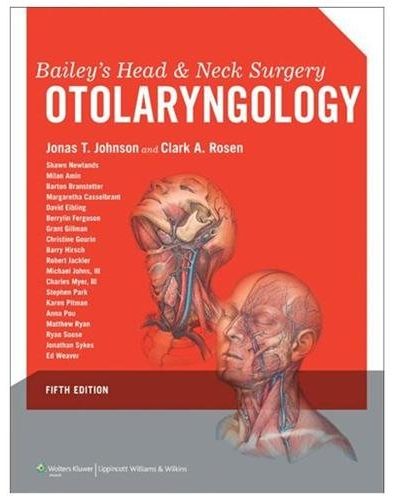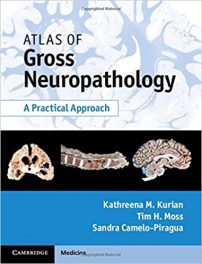 Editors: Jonas T. Johnson and Clark A. Rosen
Editors: Jonas T. Johnson and Clark A. Rosen
Publisher: Wolters Kluwer | Lippincott Williams & Wilkins –
Book Review by: Nano Khilnani
A massive, two-volume textbook spanning 3,380 pages with 12 sections and 207 chapters, this fifth edition of Bailey’s Head and Neck Surgery – Otolaryngology contains current, evidence-based knowledge for the specialist or resident in this field of medicine.
Packed with more than 3,000 full-color illustrations with accurate, intricate, and minute anatomic details, this book is designed to add value to the student or practitioner at any level, by expanding his or her understanding, retention, and ability to apply the information learned within it. This is the preeminent text in its field. It is comprehensive yet concise.
Yet, for the very large amount of knowledge contained in it, the book is practical to use and user-friendly because it contains easily readable text, helpful summary tables and other study aids that will enhance the reader’s experience. Not to forget of course the online resources available at http://solution.lww.com.
To access the complete contents of this textbook online – which are fully searchable – and to use the other valuable features, simply visit the website indicated above, enter the access code by scratching off the sticker on the inside front cover of this book, and follow the instructions online to activate your access.
The vast amount of information contained in this book was authored by 380 medical specialists and experts in non-medical subjects, mainly in the United States, but also in Australia Canada, Hong Kong, and South Africa.
Here is a broad overview of the main medical and surgical areas covered in this book, arranged according to the order in which the material was presented in it:
• Section I: Basic Science / General Medicine
• Section II: Rhinology and Allergy
• Section III: General Otolaryngology
• Section IV: Laryngology
• Section V: Trauma
• Section VI: Pediatric Otolaryngology
• Section VII: Head and Neck Surgery
• Section VIII: Sleep Medicine
• Section IX: Otology
• Section X: Facial Plastic and Reconstructive Surgery
• Section XI: Contemporary Issues in Medical Practice
A typical chapter in this book starts with a brief description of the contents in the chapter, followed by specific topics and discussions, with illustrations, Tables, and Highlights interspersed throughout the chapter.
For example in chapter 1, Surgical Anatomy of the Head and Neck, the author Michael D. Maves, starts out by writing about the following parts of the neck and head, along with sub-parts of each one:
• The Cranium: Scalp, Calvaria
• Cranial Fossae
• Eyelid, Orbit, and Eye: Tarsus, Blood Supply, Lacrimal System,
• The Ear
• Nose and Paranasal Sinuses: External Nose, Nasal Cavity, Sinuses, Ethmoid Sinuses, Sphenoid Sinus, Maxillary Sinus
• The Face: Facial Bones and Muscles, Parotid Gland, Facial Nerve
• Oral Structures: Maxilla, Palate, Mandible, Hyoid Bone and Tongue, Submandibular Gland
• Pharynx and Larynx: Nasopharynx, Oropharynx, Hypopharynx, Larynx
• The Neck: Cervical Triangles, Inferior Portion of the Neck, Lateral Portion of the Neck, Arterial Supply Venous Supply, Lymphatic Vessels, Viscera
Numerous illustrations are provided amidst the discussion of each part of the head and neck, which provides the reader various detailed anatomic looks. For example, in the section on Venous Supply, Figure 1.20 shows 20 different veins that supply blood to the neck and head, such as the subclavian vein, internal jugular vein, anterior external jugular vein, superior laryngeal vein, superior thyroid vein, common facial vein, and other veins.
A list of books for further reference and study is provided in the Bibliography at the end of the chapter.
In other chapters, other study aids are provided for better absorbing the material. For example in chapter 2, Basic Surgical Principles, Tables are provided, as well as boxed areas named Highlights.
For example Table 2.2 in that chapter entitled Wound Classification shows four types of wounds – clean, clean-contaminated, contaminated, and dirty. and how the surgeon determines what type it is. A clean wound has “no breaks in sterile technique, no inflammation, and noncontaminated skin.” On the other end of the scale, a dirty wound is described as “infected with purulent material.”
An example of a Highlights box is found also in chapter 2. In the discussion of the last topic in this chapter, Venous Thromboembolism Prophylaxis, this box specifies the risk factors in patients and the prophylactic measures to be taken to prevent VTE.
In summary, that this book has been around for about two decades and this current one is the fifth edition is sterling testimony to its wide acceptance by physicians and surgeons in the field of otolaryngology. We need say no more in praise of it.
Byron J. Bailey, MD, FACS, who started first edition of this book about 20 years ago, is Chairman Emeritus in the Department of Otolaryngology at the University of Texas Medical Branch in Galveston, Texas.
Jonas T. Johnson, MD is Professor and Chairman in the Department of Otolaryngology, the Dr. Eugene N Myers Professor and Chairman of Otolaryngology, and Professor in the Department of Radiation Oncology at the University Of Pittsburgh School Of Medicine. He is also Professor in the Department of Oral and Maxillofacial Surgery at the University Of Pittsburgh School Of Dental Medicine
Clark A. Rosen, MD is Professor in the Department of Otolaryngology at the University of Pittsburgh Medical Center; Director of the University of Pittsburgh Voice Center; and Professor in the Department of Communication Sciences Disorders at the University of Pittsburgh in Pittsburgh, Pennsylvania.
Section Editors:
Basic Science and General Medicine: Shawn D. Newlands and Karen T. Pitman
Contemporary Issues in Medical Practice: Shawn D. Newlands and Karen T. Pitman
Facial Plastic & Reconstructive Surgery: Grant S. Gillman, Stephen S. Park and Jonathan M. Sykes
General Otolaryngology: David E. Eibling and Shawn D. Newlands
Head and Neck Surgery: Christine G. Gourin and Anna M. Pou
Laryngology: Milan R. Amin and Michael M. Johns
Otology: Barry E. Hirsch and Robert K. Jackler
Pediatric Otolaryngology: Margaretha L. Casselbrant and Charles M. Myer III
Radiology: Barton F. Branstetter
Rhinology and Allergy: Berrylin J. Ferguson and Matthew W. Ryan
Sleep Medicine: Ryan J. Soose and Edward M. Weaver
Trauma: Grant S. Gillman, Stephen S. Park, and Jonathan M. Sykes.







